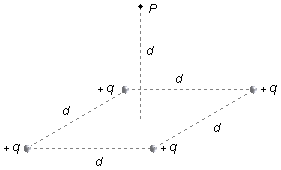Electric Field
advertisement
Electric Point Charge
A particle, with mass m and charge q, was placed at a point A of an electric
field where the vector of the electric field is vertical, pointing upwards and has magnitude
E. If we know E, m, and g (free-fall acceleration), determine:
a) The charge q, knowing that the particle is in equilibrium at point A;
b) The sign of the electric charge.
a) The charge q, knowing that the particle is in equilibrium at point A;
b) The sign of the electric charge.
Electric Charge Density
The ratio between the electric charges of two spheres is 3/4, the ratio between its radii is 5/8.
Determine the ratio between the densities of electric charge.
Discrete Distribution of Electric Charges
Determine the electric field of a dipole at the points located on the perpendicular bisector of the dipole.
Check the solution for points far from the center of the dipole.
Determine the electric field of a dipole at the points along the straight line joining the two charges of
the electric dipole.
Two equal charges of the same sign are separated by a distance 2d. Calculate the magnitude of the
electric field at the points along the perpendicular bisector of the line joining the two charges. Check
the solution for points far away from the center of the charges.
Two equal charges of the same sign are separated by a distance of 2d. Calculate the magnitude of
the electric field at the points along the line joining the two charges. Check the solution for points
far from the center of charges.
Two point charges of 5×10−6 C and 3×10−6 C, are placed
in two vertices of an equilateral triangle with sides of 1.2 m. Calculate the magnitude of the
electric field in the third vertex, assuming they are in the vacuum.
Four positive charges equal to Q, are placed on a horizontal plane in the vertices of a
square of side d.
a) Find the magnitude of the electric field at a point P above the center of the square at a distance equal to d. Assume that the Coulomb constant is equal to k0.
b) If a charge Q < 0 is placed in P, find the magnitude of the electric force will act on this charge.
a) Find the magnitude of the electric field at a point P above the center of the square at a distance equal to d. Assume that the Coulomb constant is equal to k0.
b) If a charge Q < 0 is placed in P, find the magnitude of the electric force will act on this charge.

advertisement

Fisicaexe - Physics Solved Problems by Elcio Brandani Mondadori is licensed under a Creative Commons Attribution-NonCommercial-ShareAlike 4.0 International License .